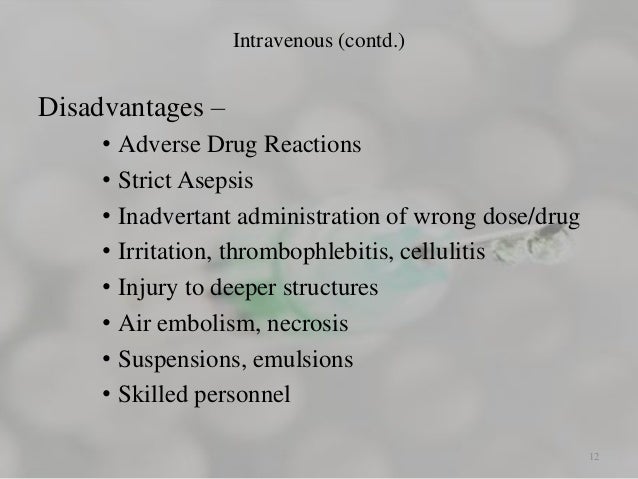
The drug is injected into the layers of the skin eg. The three main parenteral routes of drug administration are IV IM and SC and in all cases administration is usually via a hollow needle.

Given their superficial location on the skin peripheral veins provide easy access to the circulatory system and are often utilized in the parenteral administration of medications.
List four routes of parenteral administration. The most important and most frequently used parenteral routes are intravenous route IV intramuscular route IM and subcutaneous route SC. Other less frequent routes specialized parenteral routes are summarized below. This involves the administration of a drug within the vertebral column.
The two most frequent routes for intraspinal drug delivery are epidural route and. ROUTES Enteral enteron of intestine From mouth to rectum Simple safe no sterilization required Slow digestive juicesenzymes FPM Irritants emergencies etc. Parenteral par beyond.
Enteron Emergencies Rapid No FPM irritants no gastric irritation Painful invasive asepsis skilled personnel more adverse events etc. The four injection routes. Commonly used for tuberculin and systemic allergy testing.
Common sites are the inner aspect of the forearm. Upper arm upper chest or upper back beneath the scapulae are also sites for intradermal injections. For small therapeutic molecules various routes for drug administration are parenteral intravenous intramuscular and subcutaneous oral nasal ocular transmucosal buccal vaginal and rectal and transdermal.
Intravenous injection is the most common parental route of medication administration and has the benefit of bypassing the first-pass metabolism by the liver. Given their superficial location on the skin peripheral veins provide easy access to the circulatory system and are often utilized in the parenteral administration of medications. Administration of Medication by the Intradermal Route.
Intradermal injections are made into the dermal layer of skin just below the epidermis Figure 11-1. Small volumes usually 01 mL are injected. The absorption from intradermal sites is slow thereby making it the route of choice for allergy sensitivity tests desensitization injections.
-powered by a gas source small air compressor -breathing techniques. -device delivers a drug in powdered form into the lung with no propellant or external power source. Four Routes of Parenteral Administration and Approved Abbreviation.
Intramuscular IM 90 Degrees Angle. Subcutaneous SQ 45 Degrees Angle. Intradermal ID 15 Degrees Angle.
Rectally or Vaginal route 1. Drug administered through the rectum. Administers of drug liquid form into the rectum.
Advantages of Enteral Route of Drug Administration. Parenteral Route of Administration and Dosage Forms. A drug given parenterally is one given by a route other than the mouth topical dosage forms are considered separately.
The three main parenteral routes of drug administration are IV IM and SC and in all cases administration is usually via a hollow needle. Four Routes of Parenteral Administration and Approved. Four Routes of Parenteral Administration and Approved Abbreviation like before a meal Write instructions and routes of administration in full The mouth route is the most commonly used route of drug administration due to the ease in.
The routes of drug administration can be classified into three categories. Enteral parenteral and percutaneous. The term parenteral means administration by any route other than the enteralor gastrointestinaltract.
As ordinarily used the term parenteral route refers to intradermal subcutaneous subcut intramuscular IM or intravenous IV. Checklist for Parenteral Site Identification Use the checklist below to review the steps for completion of Parenteral Site Identification Directions. Identify parenteral injection sites needle sizegauge injection angle and the appropriate amount that can be administered in each of the parenteral routes.
Intradermal subcutaneous and intramuscular. Parenteral drug administration means any non-oral means of administration but is generally interpreted as relating to injecting directly into the body bypassing the skin and mucous membranes. The common parenteral routes are intramuscular IM subcutaneous SC and.
Parenteral delivery is defined by the US Food and Drug Administration FDA as drug administration by injection infusion and implantation or by some other route other than the alimentary canal. Encyclopedia of Biomedical Engineering 2019. The important parenteral routes are.
I Subcutaneous sc The drug is deposited in the loose subcutaneous tissue which is richly supplied by nerves irritant drugs cannot be injected but is less vascular absorption is slower than intramuscular. The drug is injected into the layers of the skin eg. Bacillus CalmetteGuérin BCG vaccination and drug sensitivity tests.
It is painful and only a small amount of the drug can be administered. The drug is injected into the subcutaneous tissues of. Of parenteral administration are available all of which bypass the intestinal tract the intravenous intramuscular and subcutaneous routes of administration are the most commonly used.
List 3 forms of parenteral administration and place an next to the form that provides 100 bioavailability of a drug. Interavenous injection Intramuscular Subcutaneous injection Identify and discuss 4 factors that affect absorption of a drug. Min 40 words 1 Physical form of drug A drug may be in solid or liquid form.